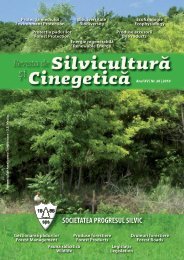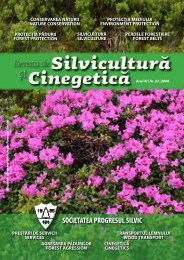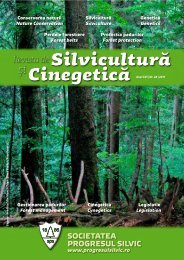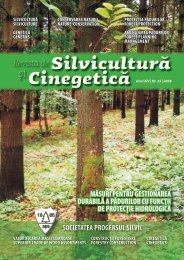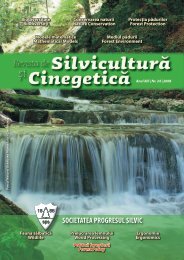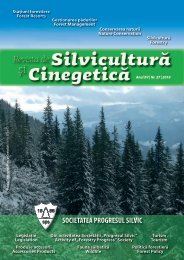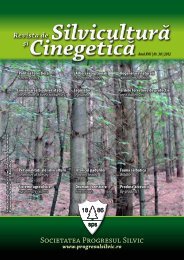Silviculture and Cinegetics Review - Societatea Progresul Silvic
Silviculture and Cinegetics Review - Societatea Progresul Silvic
Silviculture and Cinegetics Review - Societatea Progresul Silvic
Create successful ePaper yourself
Turn your PDF publications into a flip-book with our unique Google optimized e-Paper software.
FORESTRY BELTS SILVICULTURE AND CINEGETICS REVIEW XVII/30/2012<br />
- Level at the lower threshold of the optimum<br />
magnesium interval (below PT: 2500 ppm): 1090<br />
ppm;<br />
- Average nitrogen pollution (as PT: 17000 ppm):<br />
16240 ppm;<br />
- High calcium pollution (PT: 8000 ppm): 11972 ppm.<br />
Photo 7. Spruce (between houses -- str. Baciului nr. 8, Stupini<br />
– Braşov) where needles were collected for foliar analysis<br />
In March 2010, foliar analyzes conducted at the<br />
spruce trees located near the northern ground wave<br />
(Photo 7) (nearby Stupini belt - Brasov), indicates the<br />
following levels of substances (Table 2):<br />
- Sodium below the threshold of toxicity (PT 200<br />
ppm): 136 ppm;<br />
- Zinc below the threshold of toxicity (PT 60 ppm):<br />
42.9 ppm;<br />
Fig. 8 Lempes Hill saw of the ground wave (west slope)<br />
- Copper (pollution) little above the toxicity threshold<br />
(PT 10 ppm): 10.7 ppm;<br />
- Iron below toxicity threshold (PT 300 ppm): 232.8<br />
ppm;<br />
- Magnesium at the lower limit of the optimum level<br />
(optimum level: 1000-2500 ppm): 1034 ppm;<br />
- Very large excess of calcium (8000 ppm PT): 14,470<br />
ppm.<br />
Tabelul 2. Foliar analysis of spruce from the neighborhood of Kronospan Braşov factory (March 2010)<br />
Metal<br />
Quantity<br />
Optimum level /<br />
Range of tolerance<br />
Toxicity<br />
threshold<br />
MU Type of substance Level characterization<br />
Sodium 136 50-200 200 ppm nutrient/pollutant<br />
optimum / tolerance<br />
interval<br />
Zinc 42.91 15-60 60 ppm nutrient/pollutant<br />
optimum / tolerance<br />
interval<br />
Iron 232.8 40-300 300 ppm nutrient/pollutant<br />
optimum / tolerance<br />
interval<br />
Manganese 10.3 50-500 500 ppm nutrient/pollutant deficiency<br />
Potassium<br />
5037 ppm nutrient/pollutant<br />
optimum / tolerance<br />
interval<br />
Cadmium 0 - 0,5 ppm pollutant absence<br />
Lead 0 - 10 ppm pollutant absence<br />
Magnesium 1034 1000-2500 2500 ppm nutrient/pollutant (deficiency) optimum<br />
Calcium 14470 3500-8000 8000 ppm nutrient/pollutant excess<br />
Copper 10.67 4-10 10 ppm nutrient/pollutant excess<br />
6. Vegetation in the area<br />
6.1. The reserve Castle Hill-Lempes (Photo 8)<br />
The vegetation includes various xerophyte<br />
associations, steppe (the southern slopes on limestone<br />
bedrock), formed in postglaciar, <strong>and</strong> nemoral<br />
associations - different species forests (sessile oak,<br />
field maple, lime, hornbeam, field maple, beech, fir,<br />
hornbeam, plantations of black pine, with<br />
undergrowth of flowering ash, hawthorn, spindle-tree<br />
, warty spindle-tree, red dogwood, cornel tree, privet,<br />
walnut, ash, blackthorn, dwarf almond, etc.). Of the<br />
shrub vegetation it is noted the rare dwarf almond<br />
species (Mygdalus nana) <strong>and</strong> wild dwarf cherry<br />
(ground cherry, Cerasus / Prunus fruticosa).<br />
91



